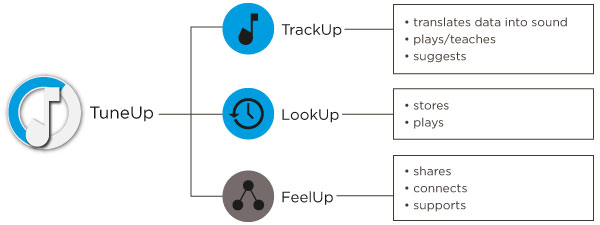How it works
The application collects data about the teenager’s blood glucose levels sent by the glucometer to the smarphone via Bluetooth. It then translates them into distortions of an audio track chosen by the user. The duration of the sound track represents the user’s day. Distortion is applied to the portion of the track connected to the part of the day in which the testing values are out of the normal range.
The collected data can be edited and brought back within the optimal glycemic range through interaction with the app. The app also allows the user to share his/her feelings with a community of diabetic teenagers: their feedback will provide emotional support.
STRUCTURE/ The app has three functional sections. TrackUp (video scenario), the application’s core, manages the acquisition, display and editing of the blood glucose values; LookUp (video scenario) is the data archive; and FeelUp builds the network of supportive co-users. The last section, FeelUp, is not completely designed yet.

SOUND/ The use of sound is a key element of the application because is both innovative compared with the current medical data visualization projects and it provides an immediate and more intuitive understanding of the glycemic levels. The sound treatment, supported by the visual representation of the glycemic values, offers a simpler way to understand how an inappropriate management of diabetes affects the audio track, metaphor for the teenager’s day.
Using the user’s smartphone audio collection allows TuneUp to avoid sound ambiguity about the correct perception of distortions: if the user already knows the song, he can easily understand when distortion is applied. The use of user’s songs also builds both a functional and emotional archive, LookUp, that easily lets the user remember and make connections between the daily activity done and the glycemic results (in form of portions of audio track) being played.
INTERFACE/ The graphic identity of TuneUp is characterized by the presence of the circle, representative and constant visual element of the app interface. The circle is meaningful because it refers to the blue circle, the universal symbol of diabetes, but also because it is a meaning for the cyclical nature of time and the cause-effect connection. Moreover, it refers to old vinyl or new dj audio-mixer. The center of the circle is the area for visualization and selection.

TuneUp uses simple geometric shapes as buttons for the navigation: each one of them has a little icon to symbolize the content. Some of the icons of TuneUp are Glyphish icons, licensed under Creative Commons, created by Joseph Wain; others have been designed specifically for TuneUp. Colours are functional and customizable between a certain number of possible colour palette: they reflect the changing teenagers’ style but, at the same time, maintain a respect for the basic rules of contrast and clarity.


